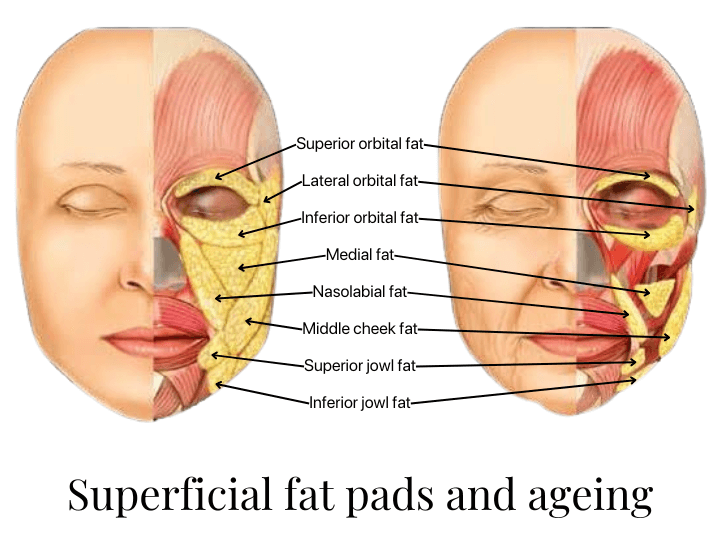Face Volume Loss Consultations Melbourne
The doctors at Victorian Cosmetic Institute have been providing consultations for the treatment of facial volume loss since its inception in 2005.
How to treat face volume loss?
A medical consultation with a doctor is necessary to evaluate and develop a suitable treatment plan for facial volume loss.
In the consultation, the doctor will take a thorough medical history and perform a physical examination of the skin. A detailed treatment plan, including cost estimates, will be provided. Additionally, a cooling-off period is given before starting the treatment.
Face volume loss in the epidermal, dermal, and hypodermal layers
Facial volume loss is influenced by changes across all three main skin layers: the epidermis, dermis, and hypodermis. Understanding these changes helps to explain why facial volume diminishes over time and highlights the importance of addressing all these skin layers in treatment strategies.
Epidermal layer
The epidermis is the outermost layer of skin, responsible for protecting underlying tissues. With age, this layer thins, and its ability to retain moisture diminishes. Although the epidermis itself does not contribute significantly to facial volume, its thinning can affect the skin’s overall texture and make underlying volume loss more noticeable.
Dermal layer volume loss
The dermal layer, known as the dermis, lies beneath the epidermis and is crucial for maintaining facial volume. It contains collagen and elastin fibres that provide structural support and elasticity. As we get older, the number of fibroblasts (cells that produce collagen and elastin) decreases. This results in reduced synthesis of collagen and elastin, leading to thinner and less dense collagen fibres. Fibroblasts are also responsible for producing essential components like the extracellular matrix, glycosaminoglycans, and hyaluronic acid. This reduction weakens the skin’s structure, causing it to lose firmness and volume. The loss of these supportive elements contributes significantly to sagging, wrinkles, and a hollow appearance in areas like the cheeks and under the eyes.
Hypodermal layer volume
The hypodermal layer, also known as the subcutaneous layer, is the deepest skin layer and contains fat pads that provide additional volume. As we age, these fat pads can shrink and shift, leading to a loss of fullness and changes in facial contours. Specifically, we tend to lose subcutaneous fat in regions like the periorbital (around the eyes), forehead, cheeks, temples, jawline, chin, glabella (between the eyebrows), and around the mouth. Conversely, fat increases in areas such as the submental region (under the chin), the outer nasolabial folds (lines running from the nose to the mouth), the labiomental crease (between the lip and chin), the jowls, under-eye pouches, and the malar fat pads (cheek area). This redistribution of fat, combined with reduced collagen and elastin in the dermis, exacerbates the appearance of volume loss.

How bone shrinkage affects facial volume
The facial bones serve as the foundation for the soft tissues of the face, giving it stability and structure. As we age, these bones gradually shrink and change shape, which reduces their support for the soft tissues. This loss can cause fat tissue and skin to shift, resulting in visible volume loss in areas of the face such as around the eyes and the jawline.
What face areas lose volume?
In the ageing process, volume loss can be observed in many areas of the face including;
- Cheeks – As we age, the cheeks lose their fullness and become flatter and more concave. This happens because the bones in the face change shape, and the fat pads in the cheeks shrink and move downward.
- Chin and Pre-Jowls – The chin and pre-jowl regions experience volume loss and changes in shape and projection with age. Women typically see decreased chin projection, while men often experience increased projection. Fat loss and mandible recession create indentations (pre-jowl sulci) and contribute to chin sagging, while repetitive muscle action can deepen the labiomental crease and cause a dimpled chin appearance (peau d’orange).
- Lips – The ageing process causes the lips and skin around them to lose definition, shape and fullness. Lips flatten and recede, the vermillion border and the tuberculum labii superiors (the double curve or bow shape in the centre of the upper lip) become less pronounced.
- Temples – Temples show signs of volume loss from age-related changes to the fat pads, resulting in a reduction in width and depth. MRI studies have shown that the soft tissue thickness in the temple region decreases by an average of 3.4mm throughout adulthood.
How can volume loss in the face be avoided?
Facial volume loss can result from both intrinsic and extrinsic factors. Intrinsic factors are those related to natural ageing processes, such as decreased collagen production and reduced fat padding, which we have limited control over. On the other hand, extrinsic factors are environmental and lifestyle influences that we can manage, such as sun exposure and diet. While we cannot stop the natural ageing process, we can take steps to mitigate the effects of extrinsic factors to help maintain facial volume. Here’s how:
- Healthy Diet: A balanced diet rich in vitamins and antioxidants supports dermal health and collagen production. Incorporate foods high in vitamins C to help promote collagen production.
- Hydration: Keeping your skin well-hydrated is crucial for maintaining its volume. Drink plenty of water throughout the day to support dermal and epidermal moisture and elasticity.
- Sun Protection: Daily use of sunscreen with a high SPF protects your skin from harmful UV rays, which can accelerate collagen breakdown and contribute to volume loss. Protecting your skin from the sun helps preserve its firmness and structure.
- Skincare Routine: Use anti-ageing skincare products containing ingredients like retinoids, peptides, and hyaluronic acid. These help to maintain skin firmness, stimulate collagen production, and prevent premature ageing.
FAQs
Who is a candidate for volume loss consultations?
Volume loss consultations are suited to those with one or more of the following concerns:
- Noticable loss of volume and skin firmness
- Changes in skin laxity and elasticity
- Volume loss following significant weight loss
Doctors at Victorian Cosmetic Institute provide medical consultations to discuss your options for volume loss treatment.
Can face volume be replaced permanently?
Recognising that ageing is a continuous and natural process is essential. Treatments for facial volume loss do not provide permanent results nor do they prevent future loss of volume. The effectiveness of these treatments varies based on the individual, the specific treatment chosen, the area being treated, and the frequency of the treatments administered.
What are the side effects of volume loss treatments?
Why choose Victorian Cosmetic Institute for your face volume loss consultation?
The doctors at Victorian Cosmetic Institute will perform a thorough assessment during your consultation with you and make recommendations as to how to address any facial volume loss. Photographs and VISIA skin analysis scan is performed to provide a baseline record prior to your consultation. A detailed quote will be provided, along with information on the potential risks and side effects.
Schedule your medical consultation by phoning 1300 863 824. Alternatively, you can book your consultation online.
Last updated July 2024
